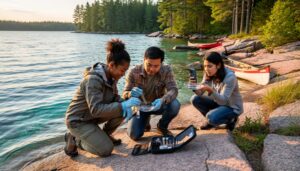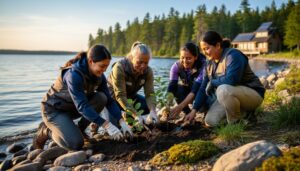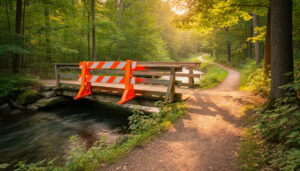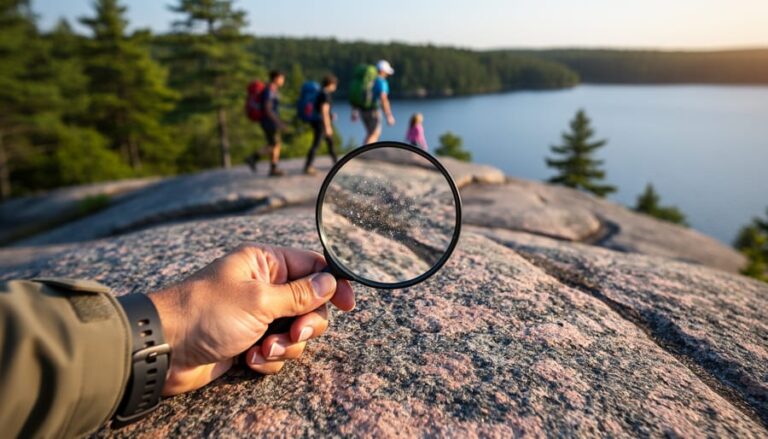Beneath the sparkling surface of Ontario’s lakes and rivers lies a fascinating world of aquatic ecology that needs your help to stay healthy. From the smallest plankton to the mightiest sturgeon, these underwater ecosystems form intricate webs of life that shape our province’s natural heritage. As climate change and invasive species pose growing challenges to our aquatic environments, citizen scientists like you play a crucial role in protecting these precious waterways.
Join a community of passionate volunteers who serve as the eyes and ears of our waters, monitoring everything from water quality to invasive zebra mussels. Whether you’re a seasoned naturalist or simply someone who loves spending time by the water, your observations and dedication can make a real difference in preserving Ontario’s aquatic habitats for future generations.
Ready to dive in? Learn how to identify key species, collect vital data, and contribute to the scientific understanding of our local waterways while connecting with like-minded nature enthusiasts in your community.
Why Ontario’s Waters Need Your Help
The Growing Threat to Our Lakes
Ontario’s lakes face mounting challenges from unwelcome visitors that threaten our cherished waterways. Species like the zebra mussel, which arrived in the Great Lakes via ship ballast water, now blanket lake bottoms and clog water intake pipes. The aggressive round goby fish outcompetes native species for food and habitat, while the fast-spreading Eurasian watermilfoil forms dense mats that can make swimming and boating nearly impossible.
These invaders don’t just create inconveniences – they fundamentally alter our aquatic ecosystems. Purple loosestrife, for instance, takes over wetland areas, reducing habitat for native wildlife. The good news? There are ways to help stop invasive species from spreading. By cleaning boats thoroughly, avoiding dumping aquarium contents into waterways, and reporting sightings to local conservation authorities, we can all play a role in protecting our precious lakes and rivers.

Success Stories: When Communities Take Action
In 2021, volunteers at Lake Simcoe made headlines when their regular monitoring activities led to the early detection of invasive water soldier plants. Their quick action allowed for rapid response measures, preventing a potentially devastating spread. Similar success stories emerged from the Kawartha Lakes region, where dedicated community members partnered with local experts to restore native aquatic plant populations and improve water quality through local conservation efforts.
At Charleston Lake Provincial Park, a team of citizen scientists helped identify and protect critical habitat for endangered map turtles. Their weekly monitoring and data collection provided valuable insights that shaped conservation strategies. Perhaps most inspiring is the story from Lake of the Woods, where cottage associations and Indigenous communities joined forces to create a comprehensive watershed monitoring program that became a model for other regions across Ontario. These victories show how community action can make a real difference in protecting our aquatic ecosystems.
Getting Started as a Volunteer Monitor
Essential Equipment and Skills
To get started with aquatic ecology monitoring, you’ll need some basic equipment and skills. A reliable pair of waterproof boots or waders is essential for getting close to the water’s edge. Pack a waterproof notebook, pencils, and a digital camera for documenting your observations. Basic water testing equipment, including pH strips and a thermometer, will help you collect valuable data.
For species identification, bring along field guides specific to Ontario’s aquatic plants and animals. A magnifying glass or hand lens comes in handy for examining smaller organisms, while a white collection tray helps you temporarily observe aquatic life. Don’t forget polarized sunglasses – they reduce glare and make it easier to see beneath the water’s surface.
Important skills include basic species identification, understanding water safety protocols, and knowing how to properly record data. You’ll also want to learn proper sampling techniques and how to use GPS coordinates for location tracking. Most monitoring programs offer training sessions to help you develop these skills, so don’t worry if you’re just starting out!
Pro tip: Keep a small first-aid kit and some extra dry clothes in your car – you never know when you might need them!

Where and When to Monitor
The best time to monitor aquatic ecosystems in Ontario parks is during the warmer months, typically from late spring through early fall (May to September). During these months, water temperatures are ideal for observing aquatic life, and many species are most active. Early morning and dusk offer prime viewing opportunities when many aquatic creatures are feeding.
Popular monitoring locations include the shorelines of the Great Lakes, particularly in areas with wetland habitats. Provincial parks like Presqu’ile and Long Point are excellent spots for observing aquatic ecosystems. Inland lakes and rivers, especially those participating in biodiversity mapping efforts, provide fantastic monitoring opportunities.
Pro tip: Choose locations with easy shoreline access and clear sight lines to the water. Quiet bays and marsh areas often yield the best observations. Remember to bring waterproof boots, as you’ll likely need to wade into shallow areas. For the best experience, check with park staff about recent wildlife sightings and current water conditions before heading out.
Always monitor in pairs for safety, and avoid disturbing nesting areas or sensitive habitats. Some locations may require special permits, so check with park authorities beforehand.
What to Look For: Key Invasive Species

Plants to Watch
When exploring Ontario’s waterways, it’s crucial to keep an eye out for invasive aquatic plants that can harm our delicate ecosystems. Water hyacinth, with its deceptively beautiful purple flowers, is one of the most aggressive invaders. This floating menace can double its population in just two weeks, forming thick mats that choke out native species and block sunlight from reaching underwater plants.
Eurasian watermilfoil is another troublemaker to watch for. Its feathery leaves might look harmless, but this plant can quickly take over entire lakes, making swimming and boating difficult while disrupting fish habitats. Similarly, European frogbit, with its heart-shaped floating leaves, might remind you of tiny water lilies, but don’t be fooled – it’s an unwanted guest in our waters.
Here’s a local tip: if you spot these plants, take clear photos and note the location. You can report sightings to your local conservation authority or through the EDDMapS Ontario app. When boating or fishing, always remember to “Clean, Drain, Dry” your equipment to prevent spreading these invaders between water bodies.
Remember, prevention is our best defense! By staying informed and vigilant, we can all help protect Ontario’s beautiful aquatic ecosystems for future generations to enjoy.
Animals of Concern
Ontario’s waters face several challenges from invasive aquatic species that can harm our delicate ecosystems. The zebra mussel, perhaps our most notorious underwater invader, arrived in the Great Lakes via ship ballast water and has since spread extensively, causing both ecological and economic impacts. These tiny striped mollusks attach themselves to boats, docks, and even native species, often overwhelming local populations.
Another troublemaker is the round goby, a small but aggressive fish that outcompetes native species for food and habitat. They’re particularly fond of eating the eggs of other fish, which can severely impact local populations. Asian carp are also knocking at our door – while not yet established in Ontario’s waters, they pose a significant threat to our aquatic ecosystems.
Keep an eye out for rusty crayfish too! These aggressive crustaceans are spreading through our waterways, displacing native crayfish species and damaging aquatic plant beds that provide crucial habitat for other species. The spiny water flea, though tiny, is another concern as it disrupts the food web by consuming smaller organisms that native fish depend on.
Here’s a tip: Always clean your boat and fishing equipment thoroughly when moving between different bodies of water. This simple step helps prevent the spread of these unwanted visitors. If you spot any of these species, report them to Ontario’s Invading Species Awareness Program – every observation helps in tracking and managing these aquatic invaders.
Reporting and Recording Your Findings
When you spot an invasive aquatic species, your observation becomes invaluable to our conservation efforts. Start by taking clear photos from multiple angles – try to capture distinguishing features like fins, patterns, or unusual coloring. If possible, note the exact location using your smartphone’s GPS or by dropping a pin on a map app.
Keep a small notebook handy to record important details: date and time of observation, water conditions, approximate size of the specimen, and any notable behavior. For plant species, note whether they’re growing in clusters or isolation, and estimate the affected area’s size.
The easiest way to report your findings is through Ontario’s EDDMapS app – a user-friendly tool that lets you submit photos and observations directly from your phone. Your reports help create a real-time map of invasive species spread across our waterways.
Pro tip: Create a simple checklist before heading out. Include basics like a ruler for size reference, zip-lock bags for collecting samples (if requested by authorities), and a waterproof camera or phone case.
Remember, quality documentation makes a difference! Even if you’re unsure about a species, submit your observation anyway – our experts can help with identification. Consider joining local citizen science programs where you can team up with experienced naturalists who’ll help sharpen your identification skills.
By consistently reporting your findings, you’re contributing to a larger picture that helps scientists track and manage invasive species effectively. Plus, it’s a great way to connect with other nature enthusiasts who share your passion for protecting our aquatic ecosystems!
Ontario’s waterways are precious treasures that belong to all of us, and their protection depends on every resident and visitor doing their part. Whether you’re a weekend paddler, an avid angler, or simply someone who loves spending time by the water, you can make a real difference in preserving these vital ecosystems for future generations.
Getting involved is easier than you might think. Start by joining local conservation groups, participating in shoreline cleanups, or becoming a citizen scientist. Even small actions, like properly cleaning your boat between waterways or reporting unusual species, contribute to the bigger picture of aquatic ecosystem protection.
Remember, our lakes, rivers, and wetlands are more than just beautiful places to visit – they’re complex living systems that support countless species and provide essential services to our communities. By staying informed, spreading awareness, and taking action, we can ensure that Ontario’s aquatic environments continue to thrive.
Let’s make a commitment today to be stewards of our waters. After all, the health of our aquatic ecosystems reflects the health of our province as a whole. Together, we can protect these precious resources for generations to come.














+ There are no comments
Add yours